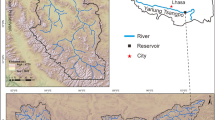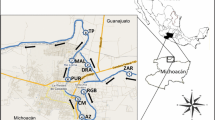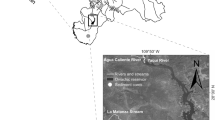Abstract
Sediment cores from the Colorado River (CR) remnant delta were used to assess the changing sedimentation and pollutant deposition processes in response to extensive human manipulation of the river. The cores are formed of alternating layers of clays and silts, with isolated sandy horizons. The clayey units are interpreted as periods of flood flows into this low gradient and meandering estuary after dam construction in the United States. The geochemistry of these sediments is particular because of the association of MnO with CaO rather than with the Fe2O3-rich clays. Past pollution of the CR delta by As, and probably also Pb and Cu, is recorded in some cores. Enrichment factors (EFs) >1 for these elements and their statistical association suggest anthropogenic inputs. The most likely sources for these element enrichments (especially As) are the arsenate-based pesticides used intensively in the area during the first half of the 20th century. The transport of these elements from the nearby agricultural lands into the present river reaches appears to have been driven in part by flooding events of the CR. Flushing by river and tide flows appear to be responsible of a lower pollutant deposition in the CR compared to the adjacent Hardy River (HR). Arsenic in the buried clay units of the HR has concentrations above the probable toxic effect level (PEL) for dwelling organisms, with maximum concentrations of 30 μg g−1. Excess 210Pb activities (210Pbxs) indicate that fluxes of this unsupported atmospheric isotope were not constant in this estuarine environment. However, the presence of 210Pbxs does indicate that these sediments accumulated during the last ~100 years. Aproximate sediment ages were estimated from the correlation of historic flooding events with the interpretation of the stratigraphic record. They are in fair agreement with the reported onset of DDT metabolites at the bottom of one core.







Similar content being viewed by others
References
Acosta y Asociados (2001) Inventario de sitios en México con concentraciones elevadas de mercurio. Comisión para la Cooperación Ambiental, INE, México
All J (2006) Environmental assessment: Colorado River floods, droughts, and shrimp fishing in the Upper Gulf of California, Mexico. Environ Manage 37:111–125. doi:10.1007/s00267-004-0184-9
Appleby PG, Oldfield F (1978) The calculation of Lead-210 dates assuming a constant rate of supply of unsupported 210Pb to the sediment. Catena 5:1–8. doi:10.1016/S0341-8162(78)80002-2
Ayuso RA, Foley NK (2002) Arsenic in New England: mineralogical and geochemical studies of sources and enrichment pathways. U.S. Geol Surv Rep 02-454. Available at: http://pubs.usgs.gov/of/2002/ofr-02-454/. Accessed March 2008
Bargagli R, Cateni D, Nelli L, Olmastroni S, Zagarese B (1997) Environmental impact of trace element emissions from geothermal power plants. Arch Environ Contam Toxicol 33:172–181. doi:10.1007/s002449900239
Baumgartner T, Ferreira-Bartrina V, Schrader H, Soutar A (1985) A 20-year varve record of siliceous phytoplankton variability in the central Gulf of California. Mar Geol 64:113–129. doi:10.1016/0025-3227(85)90163-X
Bruland KW, Koide M, Goldberg ED (1974) The comparative marine geochemistries of lead 210 and radium 226. J Geophys Res 79:3083–3086. doi:10.1029/JC079i021p03083
Cohen MJ, Henges-Jeck C, Castillo-Moreno G (2001) A preliminary water balance for the Colorado River delta, 1992–1998. J Arid Environ 49:35–48. doi:10.1006/jare.2001.0834
Covelli S, Fontolan G (1997) Application of a normalization procedure in determining regional geochemical baselines. Environ Geol 30:34–45. doi:10.1007/s002540050130
Daesslé LW, Ramos SE, Carriquiry JD, Camacho VF (2002) Clay dispersal and the geochemistry of manganese in the Northern Gulf of California. Cont Shelf Res 22:1311–1323. doi:10.1016/S0278-4343(02)00007-9)
Daesslé LW, Malagamba J, Carriquiry JD, Camacho-Ibar VF, Álvarez LG, Ortiz MC, Ramos SE (2004a) Recent sources and sinks of sediments, metals and phosphorus in the northern Gulf of California. In: Proceedings of the Gulf of California Conference June 13–15, 2004. Arizona-Sonora Desert Museum, Tucson, p 140
Daesslé LW, Camacho-Ibar VF, Carriquiry JD, Ortiz-Hernández MC (2004b) The geochemistry and sources of metals and phosphorus in the recent sediments from the Northern Gulf California. Cont Shelf Res 24:2093–2106. doi:10.1016/j.csr.2004.06.022
D’Angelo D, Norton SA, Loiselle MC (1996) Historical uses and fate of arsenic in Maine. Water Research Institute Completion Report 1986. University of Maine, Orono, p 24
DGE (1993) Plan de Ordenamiento Ecológico del Estado de Baja California. Dirección General de Ecología, Gobierno del Estado de Baja California, México, p 122
García-Hernández J, King KA, Velasco AL, Shumilin E, Mora MA, Glenn EP (2001) Selenium, selected inorganic elements, and organochlorine pesticides in bottom material and biota from the Colorado River delta. J Arid Environ 49:65–89. doi:10.1006/jare.2001.0836
Glenn EP, Lee C, Felger R, Zengel S (1996) Effects of water management on the wetlands of the Colorado River delta, Mexico. Conserv Biol 10:1175–1186. doi:10.1046/j.1523-1739.1996.10041175.x
Glenn EP, Flessa KW, Cohen MJ, Nagler PL, Rowell K, Zamora-Arroyo F (2007) Just add water and the Colorado River still reaches the sea. Environ Manage 40:1–6. doi:10.1007/s00267-006-0070-8
Gutiérrez-Galindo EA, Flores-Muñoz G, Aguilar-Flores A (1988) Mercury in freshwater fish and clams from the Cerro Prieto Geothermal field of Baja Califonia, México. B Environ Contam Toxicol 41:201–207. doi:10.1007/BF01705431
Hart RJ, Tayloe HE, Antweiler RC, Graham DD, Fisk GG, Riggins SG, Flynn ME (2005) Sediment chemistry of the Colorado River Delta of Lake Powell, Utah, 2001. USGS Open File Report 2005–1178. U.S. Department of the Interior, Washington, DC, p 33
Horowitz AJ, Elrick KA, Smith JJ (2001) Estimating suspended sediment and trace element fluxes in large river basins: methodological considerations as applied to NASQAN program. Hydrol Process 15:1107–1132. doi:10.1002/hyp.206
Hunter KA (1983) On the estuarine mixing of dissolved substances in relation to colloid stability and surface properties. Geochim Cosmochim Acta 47:467–473. doi:10.1016/0016-7037(83)90269-7
International Border Water Commission (2008) Colorado River at Southerly International Boundary. Available at: http://www.ibwc.state.gov/wad/ddqsibco.htm. Accessed March 2008
Imperial Valley/Mexicali Air Quality Taskforce (2007) Minutes of the meeting at UABC, Mexicali Campus, January 11, 2007, Mexicali, Baja California. Available at: http://www.epa.gov/border2012/docs/ workgroup-immex/ImperialMeetingMinutes1-11-07.pdf. Accessed April 2008
Joshi SR (1987) Nondestructive determination of lead-210 and radium-226 in sediments by direct photon analysis. J Radioanal Nucl Chem 116:169–182. doi:10.1007/BF02037220
Kober B, Wessels M, Bollhofer A, Mangini A (1999) Pb isotopes in sediments of Lake Constance, Central Europe constrain the heavy metal pathways and the pollution history of the catchment, the lake and the regional atmosphere. Geochim Cosmochim Acta 63:1293–1303. doi:10.1016/S0016-7037(99)00064-2
Lippmann M, Truesdell A, Frye G (1999) The Cerro Prieto and Salton Sea geothermal fields—Are they really alike? In: Proceedings of the Twenty-Fourth Workshop on Geothermal Reservoir Engineering January 25–27, 1999. Stanford University, Stanford, CA, SGP-TR-162, pp 1–10
Luecke D, Pitt J, Congdon C, Glenn E, Valdes C, Briggs M (1999) A delta once more: restoring riparian and wetland habitat in the Colorado River Delta. Environmental Defense Fund Publications, Boulder, CO, p 51
MacDonald DD, Ingersoll CG, Berger TA (2000) Development and evaluation of consensus-based sediment quality guidelines for freshwater ecosystems. Arch Environ Contam Toxicol 39:20–31
Matsui M, Hose JE, Garrahan P, Jordan GA (1992) Developmental defects in fish embryos from Salton Sea, California. B Environ Contam Toxicol 48:914–920. doi:10.1007/BF00201154
Mora MA, Anderson DW (1991) Seasonal and geographical variation of organochlorine residues in birds from Northwest Mexico. Arch Environ Contam Toxicol 21:541–548. doi:10.1007/BF01183876
Moreno-Mena JA, López-Limón MG (2005) Desarrollo agrícola y uso de agroquímicos en el valle de Mexicali. Estud Fronter UABC Mex 6:119–153
Palacios-Fest MR (1990) The modern Colorado-River delta. In: Davis OK (ed) Quaternary geology of Bahía Adair and the Gran Desierto region. International Geological Correlation Program, p 31
Persaud D, Jaagumagi R, Hayton A (1993) Guidelines for the protection and management of aquatic sediment quality in Ontario. Ontario Ministry of Environment and Energy, p 24
Peryea FJ (1998) Historical use of lead arsenate insecticides, resulting soil contamination and implications for soil remediation. Proceedings of the 16th World Congress of Soil Science, Montpellier, France, 20–26 August 1998. Available at: http://soils.tfrec.wsu.edu/leadhistory.htm. Accessed March 2008
Preiss N, Mélières MA, Pourchet M (1996) A complitation of data on lead 210 concentration in surface air and fluxes at the air-surface and water-sediment interfaces. J Geophys Res 101(D):28847–28862
Rama KM, Koide M, Goldberg ED (1961) Lead-210 in natural waters. Science 134:98–99. doi:10.1126/science.134.3472.98
Ramos-Delgado NAJ (2008) Plaguicidas organoclorados en sedimentos del delta del Río Colorado. Unpublished MSc thesis. Universidad Autónoma de Baja California, Mexico, p 80.
Randle TJ, Lyons JK, Christensen RJ, Stephen RD (2006) Colorado river ecosystem sediment augmentation approval engineering report. Reclamation managing water in the West. U.S. Department of the Interior, Washington, DC, p 78
Richardson CW, Price JD, Burnett E (1978) Arsenic concentrations in surface runoff from small watersheds in Texas. J Environ Qual 7:189–192
Robinson GR Jr, Ayuso RA (2004) Use of spatial statistics and isotopic tracers to measure the influence of arsenical pesticide use on stream sediment chemistry in New England, USA. Appl Geochem 19:1097–1110. doi:10.1016/j.apgeochem.2004.01.009
Ruiz-Fernández AC, Hillaire-Marcel C, Ghaleb B, Soto-Jiménez M, Páez-Osuna F (2002) Recent sedimentary history of anthropogenic impacts on the Culiacan River Estuary, northwestern Mexico: geochemical evidence from organic matter and nutrients. Environ Pollut 118:365–377. doi:10.1016/S0269-7491(01)00287-1
Shumilin EN, Carriquiry JD, Camacho-Ibar VF, Sapozhnikov D, Kalmykov S, Sánchez A, Aguíñiga-García S, Sapozhnikov Y (2002) Spatial and vertical distributions of elements in sediments of the Colorado River Delta and Upper Gulf of California. Mar Chem 79:113–131. doi:10.1016/S0304-4203(02)00059-2
Smith SL, MacDonald DD, Keenleyside KA, Ingersoll CG, Field LJ (1996) A preliminary evaluation of sediment quality assessment values for freshwater ecosystems. J Great Lakes Res 22:624–638
Sykes G (1937) Delta, estuary, and lower portion of the channel of the Colorado River 1933–1935. Carnegie Institution of Washington, Washington, DC, p 70
Topping DJ, Rubin DM, Vierra LE Jr (2000) Colorado River sediment transport, 1. Natural sediment supply limitation and the influence of Glen Canyon Dam. Water Resour Res 36:515–542. doi:10.1029/1999WR900285
Valdés-Casillas C, Hinojosa-Huerta O, Muñoz-Viveros M, Zamora-Arroyo F, Carrillo-Guerrero Y, Delgado-Garcia S, Lopez-Camacho M, Glenn EP, Garcia J, Riley J, Baumgartner D, Briggs M, Lee CT, Chavarria-Correa E, Congdon C, Luecke D (1998) Information database and local outreach program for the restoration of the Hardy River wetlands, lower Colorado River delta, Baja California and Sonora, Mexico. Instituto Tecnológico y de Estudios Superiores de Monterrey (ITESM), Campus Guaymas, p 102
Venkatesan MI, de Leon RP, van Geen A, Luoma SN (1999) Chlorinated hydrocarbon pesticides and polychlorinated biphenyls in sediment cores from San Francisco Bay. Mar Chem 64:85–97. doi:10.1016/S0304-4203(98)90086-X
Yarto-Ramírez M, Gavilán-García A, Castro-Díaz J (2004) La contaminación por mercurio en México. Gaceta Ecol INE Mex 72:21–34
Acknowledgments
We acknowledge the field support of E. Ortiz, N. A. Ramos, and E. Ceseña and the laboratory assistance in Germany of R. Chandrajith, A. Baier, D. Lutz, M. Hertel, and M. Döni. K.L.I. and M.M. were sponsored by a scholarship from CONACYT. Financial support from UABC-IIO-5038 and PROMEP-UABC-CA130-2007 for this project is acknowledged, as well as SEP-FOMES 1999–2001 grants for the purchase of equipment at UABC. Thanks go to the three anonymous reviewers and to V. Camacho, who helped us to significantly improve an earlier version of this work. The research was carried out during a visit by L.W.D. at Friedrich-Alexander Universität Erlangen-Nürnberg, Germany, kindly sponsored by the Alexander von Humboldt Foundation through a Georg Forster fellowship.
Author information
Authors and Affiliations
Corresponding author
Rights and permissions
About this article
Cite this article
Daesslé, L.W., Lugo-Ibarra, K.C., Tobschall, H.J. et al. Accumulation of As, Pb, and Cu Associated with the Recent Sedimentary Processes in the Colorado Delta, South of the United States-Mexico Boundary. Arch Environ Contam Toxicol 56, 680–692 (2009). https://doi.org/10.1007/s00244-008-9218-2
Received:
Accepted:
Published:
Issue Date:
DOI: https://doi.org/10.1007/s00244-008-9218-2




